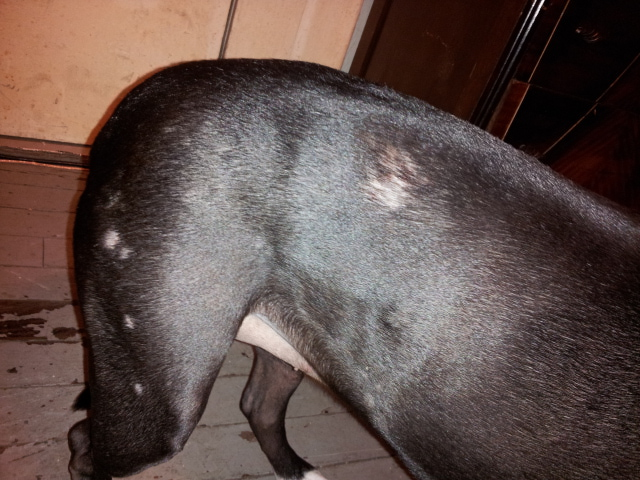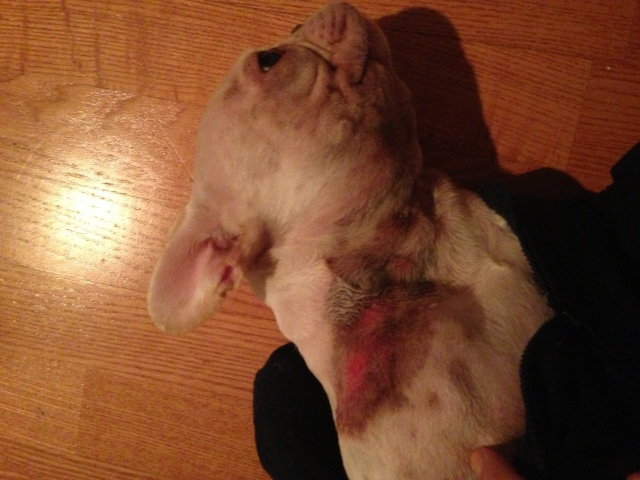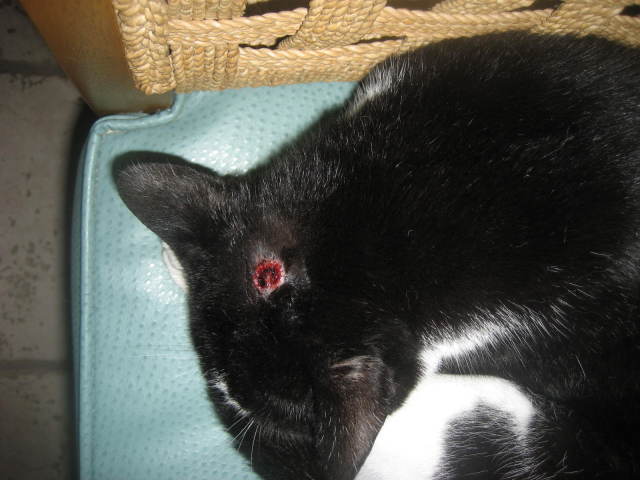QuestionMy Retriever-X is 14 years old. She has a red-inflamed ear with crusty patches inside. I have cleaned it with anti-bacterial hand soap, and put neosporin on it; but it still looks sore and she shakes her head. Could a food allergy cause this? She loves to eat my cats' food which is mostly poultry-based. She eats Costco brand canned food(chicken/rice and lamb/rice) and Purina-One Salmon-flavored dry dog food. I give her 1000mg fish oil, 250mg ester C, 200i.u.Vitamin E, 8000i.u.Vitamin A, and a glucosamine, chondrotin, MSM supplement daily. (per my veterinarian's advice)
Thanking you in advance--Bonnie Hill
AnswerHello Bonnie -
Yes, it is very possible your pet has a food allergy. Several studies have shown that some ingredients are more likely to cause food allergies than others. In order of the most common offenders in dogs are beef, dairy products, chicken, wheat, chicken eggs, corn, and soy. As you may have noticed, the most common offenders are the most common ingredients in dog foods. This correlation is not a coincidence. While some proteins might be slightly more antigenic than others, many proteins are similar in form and the incidence of allergic reactions are probably associated with the amount of exposure. For example, pet foods have historically been made up of beef, chicken, corn, and wheat. In an effort to combat food allergies, several companies produced a diet made of lamb and rice. There was nothing special about lamb and rice diets except those two ingredients were normally not present in pet foods. Animals had not eaten lamb or rice before, and therefore, had not developed an allergy to it yet. If the main ingredients in pet food become lamb and rice, then it would stand to reason that the most common problem foods could become lamb and rice. The determinant of whether a food is likely to cause a food allergy or not is based on the structure and size of the glycoprotein in the food. In addition, many lamb and rice-based foods contain many other ingredients, and if the animal has a food allergy to any of them, this lamb and rice food will do nothing to treat the food allergy. In addition, while many people criticized and blamed preservatives and flavorings as a source of food allergies, studies have shown that they are not the causes, and while we may not have justifiable health concerns about preservatives, food allergies is not one of them. She may be allergic to the cat food which you stated is poultry based and/or the canned poultry blend. So many pet food carry animals by products of poultry and beef that it is hard to really tell. Try keeping her off and away from these foods and see if her ears clear up.
The symptoms of food allergies are similar to those of most allergies seen in dogs and cats. The primary symptom is itchy skin. Symptoms may also include chronic or recurrent ear infections, hair loss, excessive scratching, hot spots, and skin infections that respond to antibiotics but reoccur after antibiotics are discontinued. There is evidence that dogs with food allergies may sometimes have an increased incidence of bowel movements. One study showed that non-allergic dogs have around 1.5 bowel movements per day where some dogs with food allergies may have 3 or more per day. It is difficult to distinguish an animal suffering from food allergies from an animal suffering from atopy or other allergies based on physical signs. However, there are a few signs that always make me suspect food allergies. One of these, is a dog with recurrent ear problems, particularly yeast infections. Another, is a very young dog with moderate or severe skin problems. A third tip off, is if a dog suffers from allergies year-round or if the symptoms begin in the winter. And the final clue, is a dog that has very itchy skin but does not respond to antihistamines or steroid treatment.
You may want to discuss a food trial with your veterinarian. A food trial consists of feeding an animal a novel food source of protein and carbohydrate for 12 weeks. A novel food source would be a protein and carbohydrate that the animal had never eaten before. An example would be rabbit and rice, or venison and potato, or duck and rutabagas. These are homemade diets but there are several commercial diets available on the market. Special Foods produced by Life's Abundance, Purina, and a food named EXclude are used by many dermatologists. Regardless of the diet used, it must be the only thing the animal eats for 12 weeks. This means no treats; absolutely nothing but the special food and water. Young growing pets have special dietary needs and a homemade diet that only contains one protein and one carbohydrate with no multivitamin or fatty acid may not be suitable even for only twelve weeks.
If this problem has recently occurred you may want to visit with your vet to check for signs or sarcoptic mange or other skin disorders.
I am quite pleased to hear of the supplements you are currently giving your pet. They are all wonderful and will greatly help your pets overall health.
The best advice I can give you for the allergy is to monitor the food intake and see if there is a progressive change. Also begin to add a supplement of Garlic powder to her food. Garlic is an anti-microbial and will help to rid the body of bacteria and/or infection. It will destroy any bacteria present and will increase healing time by 70%. Don't be afraid to sprinkle the Garlic with a heavy hand, dogs love Garlic and she should eat it up right away. The only draw back to adding Garlic to the food is flatulence. It may be a little stinky but the Garlic is working its way through the system helping to heal from the inside out. Just keep a couple clothes pins handy!
As far as the lesions in the ears, I would apply a drop of Tea Tree Oil in a carrier oil base of Vitamin E. Tea tree oil is wonderful and will heal up the lesion in no time. You can keep tea tree oil handy for any cuts or bruises as well. You don't need to apply Vitamin E oil on any other part of the body only when applying near the face, mucous membranes and ears.
If you are not comfortable with the Tea tree oil, you may rub Aloe vera gel on the lesion. Be sure its either from the plant itself or from an organic source. Even if your pet licks it, the Aloe is still getting into the body system and will heal from the inside out. Either remedy will prove a positive result.
I hope this information has helped you and your pet.
If you would like further information on natural and herbal remedies for human and animal concerns please contact me at wintersaurora@yahoo.com and I will be happy to assist you and send you a catalog of my home made herbal remedies.
Thank you and best wishes to you and your pet. Again I am very happy to hear you vet has recommened natural supplements in aiding your aging dogs health. :>)
Sincerely,
Sharon Hubbs, AHG
Certified Natural Health Consultant & Herbalist

 Bulging cervical disc nujoint plus; supplements for disc pain ;
QuestionMy 60 lb, Shepherd-Chow mix is 11 years old. Th
Bulging cervical disc nujoint plus; supplements for disc pain ;
QuestionMy 60 lb, Shepherd-Chow mix is 11 years old. Th
 Itchy Pitbull Girl ; canine dermatitis ;
Question
patchy hair bump
Hi There!
Read
Itchy Pitbull Girl ; canine dermatitis ;
Question
patchy hair bump
Hi There!
Read
 French bull dog with bad allergies
Question
Boo Scratch
I am Stuck In a nightmare,
French bull dog with bad allergies
Question
Boo Scratch
I am Stuck In a nightmare,
 Alternatives to Clavamox for an abscess
Question
Heal Me
My sweet little cat had an abscess on
Alternatives to Clavamox for an abscess
Question
Heal Me
My sweet little cat had an abscess on
 bull dog head shakes / NuVET and Vitamin E may help....
Questionjade
QUESTION: my 3 year old femal
bull dog head shakes / NuVET and Vitamin E may help....
Questionjade
QUESTION: my 3 year old femal